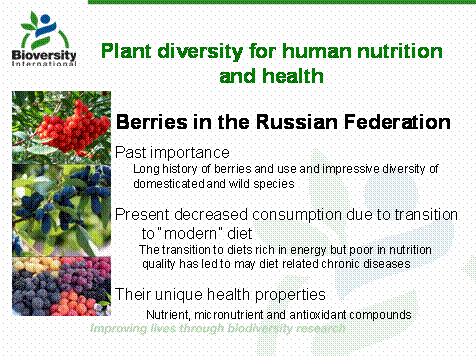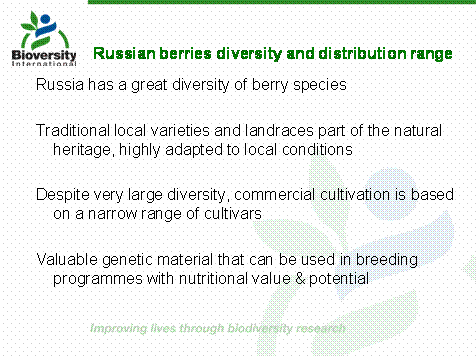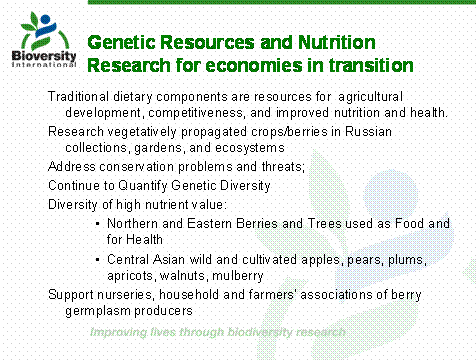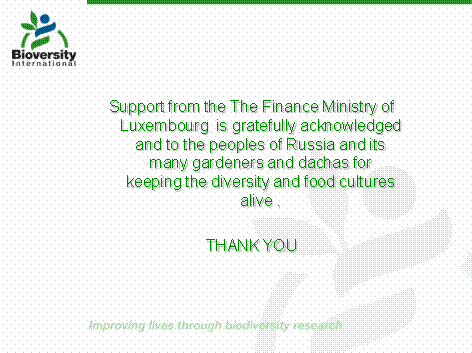
| 06.04.2011 Ñàíêò-Ïåòåðáóðã |  |
|
STATEMENT OF THE INTERNATIONAL WORKING GROUP Scientists at the Vavilov Institute VIR complete three year study of berry fruit and potato genetic resources held in the Vavilov genebank in collaboration with scientists from Luxembourg’s Centre for Public Research- Gabriel Lippmann and Bioversity International based in Rome. The international team of scientists investigated Russian berry fruits such blue honeysuckle (Lonicera), rowan or mountain ash (Sorbus), raspberry (Rubus) and black currant (Ribes) which contain a rich genetic diversity and a host of nutritional components such as minerals and vitamins and phytochemical compounds (polyphenols). The nutrient and biochemical properties in Russian berries have important potential for addressing the dramatic increase in diet-related chronic diseases in the Russian Federation. Cardiovascular diseases, stroke, diabetes and obesity are estimated by the World Bank to cost US$ 550 billion in lost income to the Russian economy between 2005-2015. In addition Russia faces the added cost of treating a large proportion of the population with chronic diseases related to simplified and nutritionally poor diets. Fortunately, the genetic resources that could help reverse this trend exist and are available in the Vavilov Institute’s collections in Pavlosk and throughout Russia. The polyphenols contained in these fruits are known to be essential and important compounds to protect the body against chronic diseases as well as conferring benefits in regulating metabolic functions including glycemic control. Vavilov scientists have also documented the distribution of these nutritionally important species in forests, gardens, dachas throughout the country. VIR has recommended types for a range of growing environments and purposes. With this latest genetic and biochemical research, VIR scientists can now say which types are likely to be important tools in the fight against poor nutrition and chronic diseases. Given the global importance and value of the berry and fruit collection at VIR, one of the largest and most representative of genetic diversity in northern temperate berries and fruits, the international team of scientists worked to improve the conservation of these genetic resources using biotechnology, and molecular genetic techniques. The scientists now have information to determine how and which samples are most important for conservation. VIR’s potatoes collection proved a rich mine of experience and genetic diversity for improving conservation techniques at extreme low temperature, in vitro, and in field genebanks. The genetic resources held at VIR, including the berries and fruits at the Pavlosk Research Station is a strategic resource of global and national value. The scientists concluded that their value from a nutritional standpoint is much greater than was previously known. The diversity that is contained in these collections provides a sound scientific basis to identify and promote those cultivars and fruits that can help reverse a growing threat to the well-being of Russian peoples and their economy. The experience of working across borders and across disciplines including biochemistry, genetics, agronomy, nutrition and anthropology proved to be very productive. The research on VIR genetic resources clearly linked their potential to the goals of agriculture, health, environment and culture. The fact that the production and gathering of berry fruits in dachas, gardens, and forests remains an important element in Russian culture, and that their consumption and preparation in drinks and jams remains part of the national food culture is one more reason to conserve and use these resources to maintain the health and well being of people in Russia. The VIR scientists and their international partners are publishing a series of scientific articles documenting their important findings. Scientific results of the project proved once again the global importance of plant genetic resources stored at VIR. The world community expects for the Russian Federation to ratify the International Treaty on Plant Genetic Resources for Food and Agriculture to ensure food security in the world and human health. This important step of the Russian Government will stimulate fruitful international cooperation in the sphere of conservation and study of the Vavilov collection.
30-31 March 2011, St. Petersburg, Russia    
|